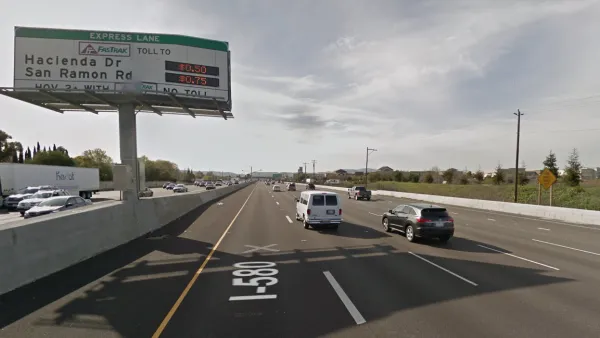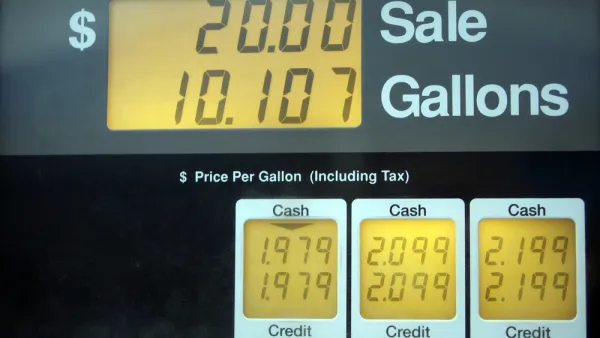$15 million in a U.S. Department of Transportation grant program is now available for states to implement pilot projects based on a "user-based alternative revenue mechanism," aka vehicle-miles-traveled fee.
As most Planetizen readers know, Congress has chosen to continue the transportation funding practice, first begun in 2008, of transferring tens of billions of dollars from the General Fund to the Highway Trust Fund, though now they use what can best be described as gimmicks (also known as "pay-fors") to offset the transfers.
The largest such transfer, $70 billion, resulted from the passage of the 5-year, transportation bill, Fixing America's Surface Transportation Act or "FAST Act" last December. It was "paid-for" by selling oil in the Strategic Petroleum Reserves, liquidating a Federal Reserve surplus account, et.al., as noted earlier.
But what Congress also did was to include funding for states to essentially do what Congress couldn't or wouldn't do. No, I refer not to increasing the federal gas tax, but to paving the path toward a sustainable funding mechanism, the vehicle-miles-traveled (VMT) fee, which is immune from increases in vehicle fuel efficiency, and the shift, even if slow, to electric vehicles.
A Federal Highway Administration (FHWA) press release Tuesday announced the availability of grants in 2016, year one of the 5-year, $95 million Surface Transportation System Funding Alternatives (STSFA) grant program.
The U.S. Department of Transportation's Federal Highway Administration today announced $15 million in grants for states under a new program to test alternative revenue mechanisms to help sustain the long-term solvency of the Highway Trust Fund.
Fiscal year 2016 2017 2018 2019 2020 Authorization $15 M
$20 M
$20 M
$20 M
$20 M
Credit: FAST Act.
For the most part, that means adopting vehicle-miles-traveled (VMT) fee pilot programs like the California Road Charge Pilot that will begin this July, or the two pilots that preceded the OReGO program. However, don't expect to see "VMT fee." Instead, the program refers to "user-based alternative revenue mechanism," as if we didn't have enough terms to describe being charged for how much you drive as opposed to how much gas you burn.
"This program will take technological innovation to a new level and help to make the entire transportation network more reliable for commuters, businesses, and freight shippers," said U.S. Transportation Secretary Anthony Foxx in the press release.
However, Ben Miller, staff writer for Government Technology and FutureStructure, points to "a catch — the administration will only fund projects that can help out the Highway Trust Fund."
“The mechanism would ultimately need to demonstrate that it could effectively collect federal user fee revenue and be scalable nationally, but it could also be used to collect state user fee revenue,” Transportation Department spokesperson Nancy Singer wrote in an email. “It should be noted that during the demonstration, federal user fee revenue would not actually be collected; rather, the pilot approach would demonstrate how it could be collected.”
"The grants are only available to states or groups of states," notes the press release, thus groups like the Western Road Usage Charge Consortium would be eligible. See Bruce Melzer's extensive piece in Toll Road News last April on progress made by some of the members [see member map (PDF)]
Hat tip to AASHTO Daily Transportation Update.
FULL STORY: U.S. DOT Annouces First Year of Grant Funding for State VMT Fee Pilot Programs

National Parks Layoffs Will Cause Communities to Lose Billions
Thousands of essential park workers were laid off this week, just before the busy spring break season.

Retro-silient?: America’s First “Eco-burb,” The Woodlands Turns 50
A master-planned community north of Houston offers lessons on green infrastructure and resilient design, but falls short of its founder’s lofty affordability and walkability goals.

Delivering for America Plan Will Downgrade Mail Service in at Least 49.5 Percent of Zip Codes
Republican and Democrat lawmakers criticize the plan for its disproportionate negative impact on rural communities.

Test News Post 1
This is a summary

Test News Headline 46
Test for the image on the front page.

Balancing Bombs and Butterflies: How the National Guard Protects a Rare Species
The National Guard at Fort Indiantown Gap uses GIS technology and land management strategies to balance military training with conservation efforts, ensuring the survival of the rare eastern regal fritillary butterfly.
Urban Design for Planners 1: Software Tools
This six-course series explores essential urban design concepts using open source software and equips planners with the tools they need to participate fully in the urban design process.
Planning for Universal Design
Learn the tools for implementing Universal Design in planning regulations.
EMC Planning Group, Inc.
Planetizen
Planetizen
Mpact (formerly Rail~Volution)
Great Falls Development Authority, Inc.
HUDs Office of Policy Development and Research
NYU Wagner Graduate School of Public Service




























